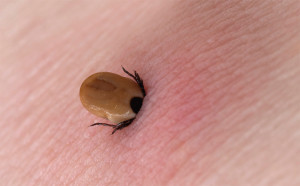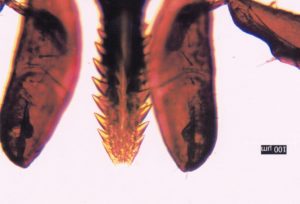 Living in Massachusetts, Charlton residents certainly know a thing or two about deer ticks. Tick populations are at epic proportions, making us experts in finding and removing ticks whether we like it or not.
Living in Massachusetts, Charlton residents certainly know a thing or two about deer ticks. Tick populations are at epic proportions, making us experts in finding and removing ticks whether we like it or not.
As we all know, deer ticks can’t simply be brushed off; they have to be removed with great and careful effort. Just what is it about ticks that make them hang on so tight?
See: How to remove a tick
Ticks are Built to Hang On – How can we remove a tick?
 While it may seem just like any other insect bite, a tick bite is a multi-step process. Telescoping barbed mouth parts are why a tick is so difficult to remove. Reliant on its ability to latch on to a host for a several day’s long blood meal, ticks depend on the proper function of this barbed appendage. If they were easy to remove it would make it impossible for them to get a full meal as a change of clothes would cause them to fall. The anatomy of a tick’s mouthparts is where a great deal of the magic happens that allows them to feed successfully for days on their host. The Scientific American recently published a fantastic story explaining exactly how these very specific mouthparts function.
While it may seem just like any other insect bite, a tick bite is a multi-step process. Telescoping barbed mouth parts are why a tick is so difficult to remove. Reliant on its ability to latch on to a host for a several day’s long blood meal, ticks depend on the proper function of this barbed appendage. If they were easy to remove it would make it impossible for them to get a full meal as a change of clothes would cause them to fall. The anatomy of a tick’s mouthparts is where a great deal of the magic happens that allows them to feed successfully for days on their host. The Scientific American recently published a fantastic story explaining exactly how these very specific mouthparts function.
Charlton Ticks Bite
By studying ticks under a microscope during the process of embedding into a mouse ear, scientists have been able to learn a great deal about their successful feedings. Think about this microscopic process next time you get a tick bite:
- Ticks burrow into their host’s skin with “two telescoping, barbed structures called chelicerae.”
- Next, they spread their chelicerae apart like two arms doing the breast stroke.
- When they spread the chelicerae a “spikey, swordlike appendage” called the hypostome, sinks into the host.
- The hypostome forms a tube for the process of withdrawing blood from the host.
With anatomy made specifically for their long-term blood meal habits, a tick bite is an efficient feeding process. While the little blood they take doesn’t seem to do us so much harm, the bacteria and viruses ticks can spread during the process is something to cause concern. With Lyme disease, Anaplasmosis and Rocky Mountain Spotted fever being spread so easily, avoiding ticks and tick bites is the best option for staying healthy.
Charlton tick control is essential.
I am committed to providing you the best most up-to-date information on the threat of tick-borne diseases in Tewksbury. Stay tuned for the latest on ticks in the area. Be sure to follow the 7 C’s of tick control to make certain your yard is not inadvertently attracting ticks.
Also read: Where do ticks live?


